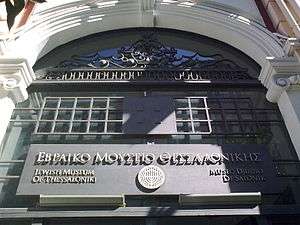Jewish Museum of Thessaloniki
Coordinates: 40°38′6.97″N 22°56′23.27″E / 40.6352694°N 22.9397972°E

The Jewish Museum of Thessaloniki (Greek: Εβραϊκό Μουσείο Θεσσαλονίκης) (Judaeo-Spanish or Ladino: Museo Djidio De Salonik) is a museum in Thessaloniki, Central Macedonia, Greece presenting the history of Sephardic Jews and Jewish life in Thessaloniki.
It is also known as: "Museum of Jewish Presence in Thessaloniki", "Jewish History Museum", Greek: "Κέντρο Ιστορικής Διαδρομής Εβραϊσμού Θεσσαλονίκης", "Μουσείο Εβραϊκής Παρουσίας στη Θεσσαλονίκη".
The museum is being run by the Jewish Community of Thessaloniki.
History
The Museum is located on Ag. Mina 13 str., in a building built in 1904 by the Italian architect Vitaliano Poselli. The restoration of the building lasted from 1998 to 2003 and was funded by the "Organisation for the Cultural Capital of Europe Thessaloniki 1997". It was inaugurated on May 13, 2001 by Evangelos Venizelos, then the Minister of Culture and Andreas Sefiha, then the president of the Jewish Community of Thessaloniki.[1] It was Sefiha who had the idea of the establishment of the Museum and started working for this in 1994.[2] The collection of the Museum was based on the collection of documents, collection of ritual objects, photographic collections and library that used to be housed in Vasileos Herakleiou 26, and was known as "The Center of the Course of Jewish history, in Thessaloniki" or "Center for the Jewish Studies of Thessaloniki" or "Jewish History Centre of Thessaloniki".
Collections
On the ground level are monumental stones and inscriptions that were once found in the great Jewish necropolis that lay to the east of the city walls. Accompanying these stones are a series of photographs showing the cemetery and visitors as it was in 1914.
Central to the first floor is a narrative history of the Jewish presence in Thessaloniki from the 3rd century BCE until the Second World War. A separate exhibit focuses on the Shoah, as it affected the Jewish Community of Thessaloniki. The majority of the community - some 49,000 persons - was systematically deported to Auschwitz and Bergen-Belsen where most of them perished.
A research and documentation center operates within the premises, which aims to document and digitize archival documents from the Museum's own collection as well as archival material from other sources, thus creating a database accessible to visitors.
The Museum provides special educational programs for schools.
This gallery shows part of the collection as this was displayed before the Museum's establishment in year 2001.
 View from outside [before 2001]
View from outside [before 2001] Exhibition of photographs relating to the Holocaust [before 2001]
Exhibition of photographs relating to the Holocaust [before 2001] The same [before 2001]
The same [before 2001] The permanent exhibition titled Thessaloniki: The Metropolis of Sephardic Jewry [before 2001]
The permanent exhibition titled Thessaloniki: The Metropolis of Sephardic Jewry [before 2001] The same [before 2001]
The same [before 2001]
Facts and figures
More than 4000 people visited the Museum from September 2009 until June 2010, mainly Jews from around the world, but also researchers who wanted to access the Museums archives and library.[3]
The museum is a member of the Association of European Jewish Museums (AEJM).
See also
- History of the Jews of Thessaloniki
- History of the Jews in Greece
- Jewish Museum of Greece
- Jewish Museum of Rhodes
References
- ↑ Aνδρέας Σεφιχά, "Αναμνήσεις μιας ζωής και ενός κόσμου", ΙΑΝΟΣ, 2010, ISBN 978-960-6882-22-7
- ↑ Βασίλης Κολώνας, "Μουσείο Εβραϊκής Παρουσίας στη Θεσσαλονίκη - Ταυτότητα, Προσανατολισμοί, Προοπτικές", Επιστημονικό Συμπόσιο "Ο Ελληνικός Εβραϊσμός", 3-4 Απριλίου 1998, Εταιρία Σπουδών Νεοελληνικού Πολιτισμού και Γενικής Παιδείας, 1998, ISBN 960-259-101-3
- ↑ "Ισραηλιτική Κοινότητα Θεσσαλονίκης, "Απολογισμός Κοινοτικού Έργου, Σεπτέμβριος 2009 - Αύγουστος 2010 - Σανά 5770"
External links
- Official site Jewish Museum of Thessaloniki (Ag. Mina 13)
- Page of the "Friends of the Jewish Museum of Thessaloniki" News, Photos and Events
- Reviews at tripadvisor
- Excerpt of Journal Article by Nicholas Stavroulakis
- Review from Frommer's
- www.sacred-destinations.com Jewish History Museum, Thessaloniki (Ag. Mina 13)
- Dukakis couple visit Jewish Museum in Thessaloniki Embassy of Greece, Press Office Washington DC, 24 April 2007
- www.hri.org Museum of the Jewish Presence in Thessaloniki (Ag. Mina 13) >> Wikimapia shows the Museum here
- www.hri.org Museum of the Cource of Jewish History in Thessaloniki (Vas. Herakleiou 26) >> Wikimapia shows the "Center of Jewish Studies" here
- www.hri.org Jewish Community / Cultural
- www.sephardicstudies.org
- Hellenic Ministry of Culture and Tourism Jewish History Centre of Thessaloniki (Tsimiski 24) >> Wikimapia does not show any museum or center here >> Address points to former address of the offices of the Jewish Community of Thessaloniki

